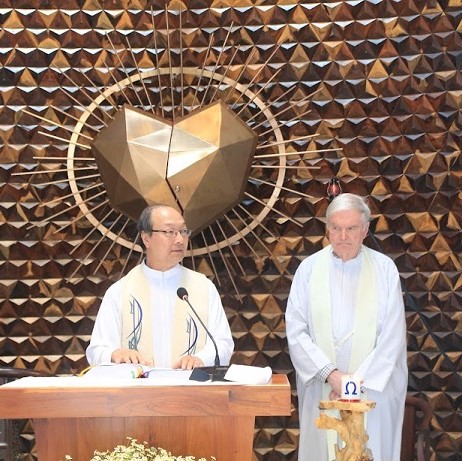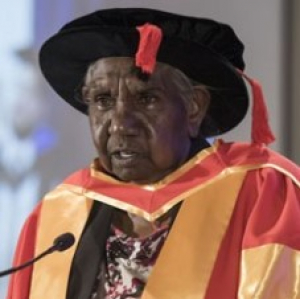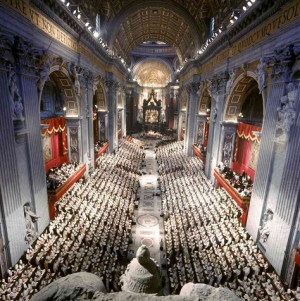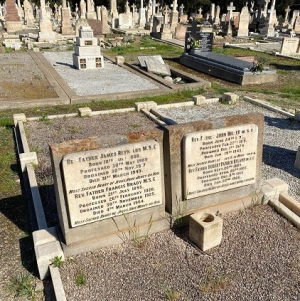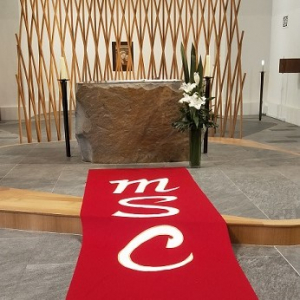Peter MALONE
By the Pricking of my Thumbs
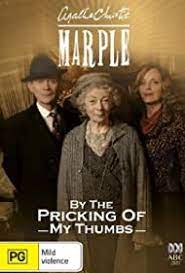
BY THE PRICKING OF MY THUMBS
UK, 2006, 103 minutes, Colour.
Geraldine McEwan, Greta Scacchi, Anthony Andrews, Charles Dance, Lia Williams, Michael Maloney, Josie Lawrence, Claire Holman, Miriam Karlin, Leslie Phillips, June Whitfield, Claire Bloom, Steven Berkoff, Patrick Barlow, O.T.Fagbenle.
Directed by Peter Medak.
Agatha Christie’s mysteries have always been popular, reinforced by the television series with Poirot and Miss Marple. While Joan Hickson’s at the norm for Miss Marple, she was also portrayed by Geraldine McEwan and Julia McKenzie.
This is a comparatively late novel by Agatha Christie, focusing on her investigators from the past, Tommy and Tuppence, now an older age, the children at home, Tommy and his work overseas, leaving Tuppence and her indulging in drinking. She is particularly concerned by an encounter with Mrs Lancaster as a no at home for the elderly where Tom is cantankerous aunt Ada is a resident (Claire Bloom). When Mrs Lancaster disappears, Tuppence becomes involved, enlisting the aid of Miss Marple.
Which means then tracking down a house in the painting left by aunt Ada, they’re finding the village, pretending to want to buy a house, getting of the people at the hotel, the local doctor, the Vicar and his ever-busy wife, as well is the Lord of the Manor. A very strong cast including Charles Dance as the vicar, Lia Williams as his wife, Michael Maloney is the local doctor. A romantic interlude has been introduced, an American soldier stationed in London, falling in love with the doctor’s daughter, her being upset because of his mysterious absence one night – later revealed as his searching for his British mother.
There is a moody background with the production of Jane Eyre with the young girl from the storekeepers in the village, and a connection with them concerning Mrs Lancaster, the visit to her lawyer (Steven Berkoff in an uncharacteristic role), and the eventual revelation of who Mrs Lancaster is (and played by talented veteran comedian June Whitfield). (Spoiler alert – she seems one of the least likely of murderers in Miss Marple stories.)
- The popularity of Agatha Christie novels? Miss Marple? The three actresses?
- The Agatha Christie novels with Tommy and Tuppence? This novel as theirs, but Miss Marple introduced, working with Tuppence and supporting her, the criticisms of the absent and sometimes arrogant Tommy?
- The introduction of Tommy and Tuppence, his overseas jobs and frequent absence, the children grown up? Tuppence, at home, her drinking, her past detection? Going to visit the home, the encounter with Mrs Lancaster and the puzzles, the encounter with aunt Ada, gruff and aggressive, her death? And the disappearance of Mrs Lancaster?
- The opening with the children, looking out the window, the overtones of the witches?
- Miss Marple and Tuppence coming to the village, pretend to be looking for a house? The painting from aunt Ada and the message, urging Tommy to follow the clues? The popular artist and his painting, visiting the expert, noting that there had been some alterations? The flowers, the rope, the mysterious person in the window?
- At the hotel, the cheery hostess, the revelation of her relationship with the vicar? The vicar, bitter, a long time in the village, previous hopes to become a bishop, his marriage to Nellie Bly? Her tolerance of his affair?
- Sir Philip, wealthy, his mansion, helping the Johnson family, financing the film of Jane Eyre, the young girl and her part, the preparations for the screening, her presence, her tantrums, the plane flying over and her being upset? The proud parents?
- Sir Philip, his sad story, the death of his wife? Nellie Bly as his secretary, absolutely devoted to him?
- To Mr Eccles, the lawyer, the information?
- Chris, the American presence, his relationship with Hannah, her being upset with him, his being unwilling to explain his absence on the Saturday? The taking of the car, the damage, the garage, the taking of Mrs Lancaster? And the revelation that he was searching for his mother and found her?
- Hannah, who work at the hotel, her father, the doctor, relationship with the vicar, the death of his daughter, the two named after flowers?
- Miss Marple and Tuppence, in the village, the drinking, the investigations, trying to find the house?
- Finding the house, finding Mrs Lancaster?
- The revelation of the truth, Mrs Lancaster being Sir Philip’s wife, her not dying, her mental collapse, his protecting her, in the house? Going to various homes for the aged? And the revelation that she was the murderer, especially of Nellie Bly?
- Tommy, the return from overseas, his presumptions in taking charge of the investigation, having to admit the talent of Tuppence? And the solving of the mystery?
Gloriavale: New Zealand's Secret Cult
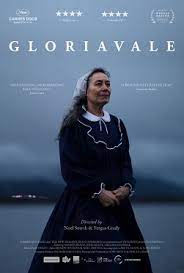
GLORIAVALE: NEW ZEALAND'S SECRET CULT
New Zealand, 2022, 89 minutes, Colour.
The Ready family, the legal advisers.
Directed by Fergus Grady, Noel Smyth.
New Zealanders are well aware of the story of Gloriavale, a religious community set up in 1969 by an Australian preacher, Arthur Cooper, who then renamed himself as Hopeful Christian. It drew a great number of people, as many as 600 at some times, including families.
In looking at the history of Gloriavale, it is clear that it ran along the patterns of many of the cult communities, the domination of the leader, his handing the domination and leadership onto a group of stewards, call servants, but who are strict and dogmatic in their interpretation of the community regulations.
There have been several television series in the mid-2010 is, so audiences interested in cults and communities have an amount of material as background. This means that this is a different kind of documentary, acknowledging the success, acknowledging the difficulties, acknowledging the legal issues and court cases. In that sense, the audience is plunged into the action between 2019 and 2022. The film presupposes audience knowledge of Gloriavale, which is not necessarily the case and many audiences would have found some initial information helpful.
The particular focus for this documentary is on one of the members of the community, John Ready, expelled from the community, trying to make contact with his wife was part of the community, eventually persuading his mother, who had been in the community for 50 years, to be interviewed and speak of her experiences. There are interviews with several other members of the family, including John’s sister. And, interviews with a number of other members who had become disillusioned.
The focus of the documentary is on John and his contact with the legal team, their investigations, their commitment, the building up of the case over several years. The documentary is personalised by the enthusiasm of the legal team as well as John Reddy’s continual participation.
While the film’s action in is in 2022, very up-to-date at the time of the film is release, it is something of a work in progress as are the investigations into Gloriavale and its leadership, its subjugation of its members, not considering them as workers to be paid, but rather as volunteers… (And, there is an alarming sequences, recorded, where the leadership give a dire interpretation of the Scriptures as regards the role of women and the forbidding of their interventions and contributions.)
Here is the brief introduction to the Gloriavale website.
Hello and welcome!
Join the thousands of visitors who have visited us in person or checked out our website. You’ll find that we are a practical group of people, bound together by a common faith in God and the hope of salvation. While the Church at Gloriavale exists to help people save their souls, the community provides the physical structure in which that occurs. The provision of work, education, housing and a full social life allows us to create a society that is Christ-centred and working on Biblical principles. Here, the aim is to make a place where it is hard to live a selfish, worldly life, but easy to find God’s will and to live in daily service to the Lord Jesus.
We seek to live a practical Christian life that mirrors life in Heaven, where there is perfect obedience to God, complete unity of thought, no self-will, no argument or strife, and no sin. We consider ourselves to have been born again into God’s family, and as God’s children, we honour God as our father and Jesus as our Lord and brother; in fact, the whole community operates as a huge family.
And an update from Wikipedia. There is a Wikipedia entry for Gloriavale, updated at the time of this review, written on October 5th, as September 29th, 2022.
Public apology
On 27 May 2022, Gloriavale's leadership issued a public apology for various sexual and child abuses and labour exploitations that occurred within their community. The leadership claimed that much had changed at Glorivale following the resignation of their previous leader and founder in 2018. The leadership agreed to allow young people to make decisions on whether to continue living at Gloriavale or moving out once they had matured. To address future sexual offending, the leadership established a "Child Protection Leads team" that answered directly to Oranga Tamariki (the Ministry of Children). The leadership also claimed to have developed a new child protection policy which encouraged members to report acts of abuse to the Police, Child Protection Leads team, and Oranga Tamariki. They also claimed to have restructured their business operations to allow parents to spend more time with their children after 3pm.
On 31 May, two senior Gloriavale leaders Fervent Steadfast and Faithful Pilgrim resigned from their positions as senior community leaders following the public apology. Steadfast had previously served as Gloriavale's financial controller and had been accused of mishandling employment issues within the community. Pilgrim had previously served as the Principal of Gloriavale Christian School until his resignation in 2020 for failing to protect pupils in his care.
Looking ahead in Vietnam
Looking ahead in Viernam

- Sent from Vietnam:
Just an update to the MSCs there that last Sunday we had our Community Gathering in Vietnam, with the blessed presence of Uncle Bob after a long time. It was a very good time for us to see each other, to update and share with one another how each one individually and at the community level are doing. We also had planned to celebrate the 20th Jubilee Year of MSC’s presence in Vietnam (2003-2023).
20th Jubilee Year of the MSC in Vietnam
Remembering Thoi Tran and Bob Irwin and the foundation, 2003
- Theme: 20 Years Of Grace: Experienced – Grateful – Confident
- Opening Jubilee Year: 21/10/2022
- Closing Jubilee Year: 21/10/2023
- Solemn Celabration date: 15/08/2023, inviting General Superior?
* Working plan: there are 3 periods
1st period: Look back on the past
2nd period: appreciate the presence
3rd period: Reach out and Step forward

I. 1ST PERIOD: LOOK BACK ON THE PAST (21/10/2022 – 08/12/2022)
- 21/10/2022: Opening Of Jubilee Year
- 08/12/2022: - Mass; Reflection about 20 years history of MSC Community Vietnam;
- Calendar distribution.
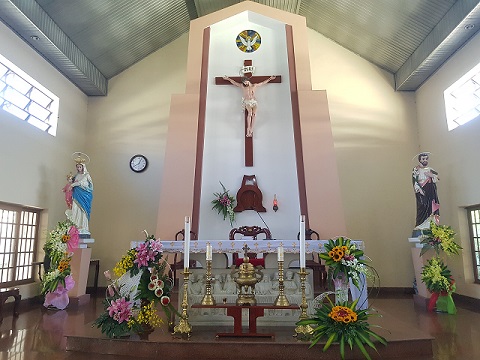
II. 2ND PERIOD: APPRECIATE THE PRESENCE (8/12/2022 – 15/08/2023)
- Jules’ birthday 15/03 (Mass) -> 11/03/2023: Núi Cúi Pilrimage.
- 28/05/2023: Sharing about mission and ministry of Vietnamese MSCs: Formation, social charity work, minitry in and oversea…
- 15/08/2023: Profession Day + Anniversary Day;
Distribution of the Dakilos (in English and Vietnamese)

III. 3RD PERIOD: REACH OUT AND STEP FORWARD (15/08/2023 – 21/10/2023)
- 21/10/2023: Closing of Jubilee Year
Mass; present a video clip about 20 years of the MSC in VN;
Sharing the vision of our MSCs’ future ministries: Mission Office, Lay, MSCs,
Sport fest among the Chevalier Family
*** Masses on: 21/10/2022; 8/12/2022; 15/3/2023; 15/8/2023; 21/10/2023 especially for the Intentions of MSC Community in Vietnam.
- Uncle Bob will compose Jubilee Prayer.
Dr Miriam-Rose Ungunmerr-Baumann AM receives her honorary doctorate from ACU
Dr Miriam-Rose Ungunmerr-Baumann AM receives her honorary doctorate from ACU

We honour Miriam Rose Ungenmerr, her life and work at Nauiyu, her art, teaching at St John’s Darwin, Dadiri and all her achievements.
Aboriginal elder, educator and artist Miriam-Rose Ungunmerr-Baumann has received a Doctor of the University (Honoris Causa) from Australian Catholic University.
The honorary doctorate recognises Dr Ungunmerr-Baumann’s servant-leadership and her contribution to new understandings of Indigenous art and spirituality, and their importance to the Catholic tradition.
ACU awarded Dr Ungunmerr-Baumann the honorary degree at a ceremony yesterday in Sydney, following her first trip to Europe to attend the funeral of Queen Elizabeth II.
“It feels very humbling to be acknowledged for my lifetime achievements,” Dr Ungunmerr-Baumann said.
A Catholic Aboriginal woman from Nauiyu near the Daly River community of the Northern Territory, Dr Ungunmerr-Baumann spent the majority of her life “walking between two worlds”.
Baptised as a teenager and given a Catholic education, Dr Ungunmerr-Baumann's teaching career started at school, when her teacher offered her a job as an assistant teacher. That same teacher encouraged her to take up university training in education. In 1975, Dr Ungunmerr-Baumann became the first fully qualified Aboriginal teacher in the Northern Territory.
While training to become an educator, Dr Ungunmerr-Baumann also developed a love of painting, and encouraged the local Nauiyu children to explore their connection to the land through art.
In 1986, she and other members of the Nauiyu community established the Merrepen Arts Centre to foster spiritual growth and education through visual arts. This led Dr Ungunmerr-Baumann to complete a Bachelor of Arts through Deakin University.
In 1993, she was appointed Principal of St Francis Xavier School in Daly River, a role she held for 13 years.
More than a decade ago, Dr Ungunmerr-Baumann launched the Miriam Rose Foundation, which she established in honour of seven young children from her Aboriginal community who died of suicide, including her own nephew, who was famously photographed as a baby with Pope John Paul II during his historic visit to Alice Springs in November 1986.
Among Dr Ungunmerr-Baumann's treasured gifts to the Australian nation is the practice of Dadiri, a form of contemplation that she describes as “the deep inner spring inside us”.
ACU Vice-Chancellor and President Professor Zlatko Skrbis said ACU was proud to honour one of Australia’s most respected leaders in society and the Church.
And a return to MSC graves. Toowoomba.
And a return to MSC graves. Toowoomba.
After Monday’s post and visit to Adelaide, some more recent photos of the MSC plot in Toowoomba.
We have featured this before but Gerry Burke took these photos to show how the plots have undergone some tidying.
Our visits to cemeteries beyond Douglas Park: Lest we Forget.
Cheers and thqnks to Gerry Burke (at Sacred Heart Day, Chevalier, 2022)

A significant 60th anniversary of an occasion that has changed all our lives profoundly
A significant 60th anniversary of an occasion that has changed all our lives profoundly

October 11th 1962 – the opening of the Second Vatican Council.

After almost four years of consultation/preparation, around 2000 bishops assembled in Rome, Pope John XXIII was carried on that soon-to-be abolished Sedia Gestatoria. They processed into St Peter’s and the doors were closed – and immediately the Pope talked about updating, renewal and exhorted the opening of the windows.

Actually, the first topic discussion was the media, means of social communication, but then the liturgy, the nature of worship and the question of the liturgy in the vernacular. (Your editor never dreamed in October in 1962 that only two and half years later, in April 1965, he would celebrate his First Mass in English.)

Four sessions, around two months each, from 1962-1965,

the spirit continuing when John XXIII died in June 1963 and Paul VI was elected.

A range of themes, the nature of the Church as the people of God,

Dialogue with contemporary world, the Joy and Hope in the Signs of the Times

Renewal of Scripture studies, mission, priesthood…

And the groundbreaking Declaration on the Relation of the Church with Non-Christian Religions

And, December 12th, Paul VI brought the Council out of the Basilica on to the steps of St Peter’s and crowds massing in the piazza for the official closure of the Council.

Seven of our MSC confreres are buried in Adelaide. Kenji Konda recently visited and sent these photos.
Seven of our MSC confreres are buried in Adelaide. Kenji Konda recently visited and sent these photos.

James Reynolds
Francis Brady

John Miller
Robert Hyland

Michael McEncroe
Arthur Bushe

Charles Laing

Surprised to find Fr Bob Hyland is buried there.
And seeing Fr Frank Brady’s name on his headstone will bring back memories, Church History, Ethics (and Pronunciations) to many of the older members of the Province.

Kenji notes there is a vacant space above Br Laing.

Chevalier Family celebration, MSC Sisters, MSC, OLSH, Lay in memory of Fr Hubert Linckens.
Chevalier Family celebration, MSC Sisters, MSC, OLSH, Lay in memory of Fr Hubert Linckens.

A Celebration of his 100th anniversary, Our Lady of Good Counsel, Deepdene.

Mary Drum, Provincial’s welcome. Sister Francis Baum spoke of Fr Linckens’ life and ministry, the foundation, his many jobs around the congregation.

Peter Hendriks MSC, representing Chris McPhee, presiding.

Congregation gathering.

The congregation

More of the congretation

The booklet

The back cover and MSC Sisters around the world.

Khoi Nguyen blesses the meal

Glimpse of cakes

And Fr Linckens himself
Blonde/ 2022
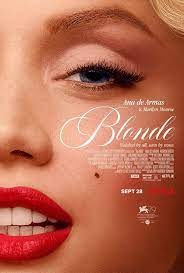
BLONDE
US, 2022, 167 minutes, Colour.
Ana de Armas, Adrien Brody, Bobby Cannavale, Casper Phillipson, Xavier Samuel, Lily Fisher, Julianne Nicholson, Sarah Paxton.
Directed by Andrew Dominik.
The Blonde of the title is Marilyn Monroe. The film is described as a “fictional biography” based on a book by American writer, Joyce Carol Oates, who emphasises the fiction by referring to her as Norma Jeane. This is a solid film, running for almost 3 hours.
It raises the question as to the place of Marilyn Monroe in 21st-century consciousness. It is 60 years since she died. She is very much a 20th-century figure, still seen when any of the film she appeared in a screened (often? not so often?). She is spoken of as a screen icon, as a screen goddess. And there is always that image of her skirt fluttering as she stands over the windy subway grating – which has become an iconic image. So, what is the interest in exploring her life, realistically or imaginatively? Older audiences will have seen her films in the past. Younger audiences may be wondering who she was, why she was so important.
The important aspect of this film is the fictional aspect. Yet, it often plays as a realistic portrait. However, the visual style moves between the real and the surreal, her life and career, yet her uncertainties, fears, determination, and having to deal with her broken family life, the initial exploitation by studio executives and others, her marriage to Joe DiMaggio, the baseball player referred to as former athlete (Bobby Cannavale0, her marriage to playwright Arthur Miller, referred to as the writer (Adrien Brody).
It should be said that the performance by Cuban actress, Ana de Armas (Knives Out, No Time to Die), is most impressive. So many times she looks and sounds like the actual Marilyn, and, we must assume, like the actual Norma. The actress identifies with both Norma and Marilyn, repeats some of the famous sequences from her films, an audition for Don’t Bother to Knock, the re-creation of the trailer for Niagara (“Niagara and Marilyn Monroe, the two most electrifying sites in the world” – from 1952), Diamonds are a Girl’s Best Friend from Gentleman Prefer Blondes, her working with Billy Wilder for The Seven Year EACH (and the iconic scene, filmed in front of the press and huge crowds of onlookers), and some re-creations of Some Like it Hot. Ana de Armas sustains the character of Marilyn Monroe, especially in her deteriorating years, the episode of going to sing for John F. Kennedy’s birthday (this scene not re-created), and her final dose, overdose, at the age of 36.
Which means that the dramatisation of the fiction means that the audience will tend to take what they see as what actually happened. There is the fearful little girl, her mentally unbalanced mother (Julianne Nicholson), the continued yearning for an absent father, one of the main motive drives in her life, a quick sketch of her becoming an adult, photos, the nude calendar, entry into films. Part of the drama is Marilyn’s involvement in a threesome, she very young, sexually adventurous after the initial exploitation by older men, and the introduction of the theme of her longing for a child, stylised visuals of a fetus, and later the experience of her pregnancy with the writer and the loss of the child. Loss of child, loss of father, hard mother (whom she eventually visits after 10 years).
The sexuality themes and her being exploited is dramatised in a scene which some audiences have found too repellent. And, in many ways it is, but it is meant to be revelatory of the sexual behaviour of President Kennedy, a bedroom scene, a fellatio scene, and his being presented as a sexually dominating abuser. And this scene in the context of her mental deterioration and her death.
On the one hand, there is a great deal that is familiar to audiences who know Marilyn Munro’s story (although this reviewer would have liked something on her going to England and working with Laurence Olivier in The Prince and the Showgirl, and, strangely, with Arthur Miller as the writer, there is nothing on The Misfits).
Obviously not a definitive portrait of Marilyn Monroe but a disturbing one, an evocative one, ultimately sad and tragic.
- Status of Marilyn Monroe, in her time, her career, Hollywood star, sex symbol, icon? Her personal life, her marriages? Connection with JF Kennedy? Her death?
- Audience interest in Marilyn Monroe? Older generations who lived during her career, immediate aftermath? Later generations, her place in memory, American history? Interest in the 21st-century? 60 years after her death?
- The work of Joyce Carol Oates, the long fictional biography, an imaginative interpretation of Marilyn Munro’s life, spelling Norma Jean with an e? The blend of fact and fiction?
- Andrew Dominik’s choice for this project, his interest in Marilyn Monroe, adapting Joyce Carol Oates? His cast, recreation of the past, stylistic photography, editing, fantasies and hallucinations, realism? The musical score? Marilyn’s songs?
- The performance by Ana de Armas, resemblance to Marilyn, looks, manner and style, voice and intonations, songs? The supporting cast bringing alive her mother, DiMaggio, Arthur Miller, Billy Wilder?
- The introduction, Norma at seven, with her mother, her wanting to find her father, her mother’s erratic behaviour? Pressurising the little girl? Being institutionalised? Norma not going to see her for 10 years? The mother in the institution in the 1950s, reactions, treatment of Norma?
- The collage illustrating Norma’s life, transition to Marilyn Munro, institutions, relatives, photography, dancing, the nude calendar, entry into films? Sufficient background to understand Norma becoming Marilyn, especially the yearning for her father, and the repercussions for and pregnancy?
- The overview of her film career, the highlights, her being tested, the audition for Don’t Bother to Knock, the trailer for Niagara, her singing in Gentlemen Prefer Blondes, the subway scene for The Seven Year Each, singing in Some Like it Hot, scenes with Tony Curtis? The many early films not refer to, films of the 50s including How to Marry a Millionaire, Bus Stop, no reference to Olivier and The Prince and the Showgirl? Nothing of the Misfits?
- Marilyn, the encounters with the studio heads, sexual assaults, rapes, the effect? The threesome, the two men, relationships with her, chaplain in control, his manner and personality, the imagining of her pregnancy? Chaplan and his friend, the later contacts, interviews? And his writing the letters in the name of her father and the effect on her?
- The media, premiers, her presence, the crowds, photographers, the paparazzi? The effect on her, her reticence, yet her performance for the media?
- The encounter with the athlete, her marriage to Joe DiMaggio, the courtship, his age, his attraction taught her, her response, security, Chaplin sending the nude photos and the effect, DiMaggio and his reaction to the subway sequence, his violence towards her, the divorce?
- The effect on her, at the Actors Studio, reading for Kazan, the playwright present, Arthur Miller and his reputation, listening, leaving, later meeting, the discussions, her analysis of Chekhov, Arthur Miller being impressed? Living together, the engagement, the wedding?
- Her life with Miller, retired, at home, domestic, the beach, friends? Her pregnancy? And her imagination and dreams? The tray, tripping on the beach, the miscarriage, the effect?
- The scenes with Billy Wilder, for The Seven Year Pitch, for Some Liked it Hot, her erratic behaviour, tantrums on set, late for filming, the scenes? Yet the finished product and its acclaim, her willing winning a Golden Globe?
- The interpretation of the story, going downhill in these years, tragic? The separation from Arthur Miller? On her own, the drugs, prescriptions, doctors?
- The shift to 1962, the invitation to JF Kennedy’s birthday? The scene in his bedroom, audience response to Kennedy lying on his bed, provocative, sexual, the conversations, his reputation? The fellatio close-up and its effect on the audience? The effect on Marilyn? Seeing Kennedy as sexually abusive? Her being hurried away from Washington after the party (and the audience not seeing her singing but audiences knowing it from the footage)?
- The final collapse, the director’s treatment of this period, the realism, surreal, blur, fantasy? The overdose and her death?
- The other dramatisations of her life, overall interpretation, other documentaries?
Humans, The
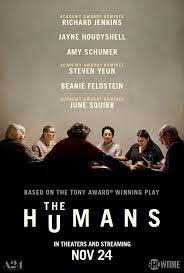
THE HUMANS
US, 2021, 108 minutes, Colour.
Richard Jenkins, Jayne Houdyshell, Amy Schumer, Benny Feldstein, Stephen Yeun, June Squibb.
Directed by Stephen Karam.
The Humans has a very strong theatrical pedigree, a Broadway play, nominee for the Pulitzer prize, winner of Tony awards, especially for Jane Houdyshell who reprises her role here on screen.
The title invites us all to identify with the characters and their situations – we are all humans. In fact, this particular family is American, a white family with the daughter having an Asian-American partner. And, the background is Irish heritage, and some Catholic themes at times to the fore. The occasion is a daughter moving into a New York apartment, not in the best condition, and inviting her parents, her grandmother and her other sister for a Thanksgiving dinner. As with a number of films where families gather for a meal, tensions and difficulties inevitably arise.
Many audiences will be interested in the characters and their portrayals and want to stay with them for this Thanksgiving meal. And, many audiences will not be interested at all in them, and, after encountering them, want to opt out of their Thanksgiving.
The characters are not particularly likeable, not entirely dislikeable. They are human. Richard Jenkins plays Eric, the father, rather broody, at times on edge, missing out on sensitivity with his wife and daughters. His wife, Deirdre, is Jayne Houdyshell, not a familiar face for many on screen, but has some very powerful moments here. Veteran June Squibb, aged 91 during filming, is the grandmother, more than a touch of dementia (though a wonderfully lucid moment as they pray grace before meals and she joins in, and their delight in saying it again so that she can pray happily). The two daughters Amy Schumer, rather restrained from her comedy shows, and the often exuberant Beanie Feldstein. Steve Yeun (Oscar nominee for his role in Minari) is her partner who is exercising all his culinary skills, practicalities, sensitivity to family.
The setting is the interior of the apartment – with some moments, finally, on the roof. The film is strong on dialogue.
The director is the writer of his play who also directed it on a Broadway. Which means then that we are seeing his different, cinematic interpretation. We would probably be more at ease watching this drama in the theatre, watching the stage, the proscenium, making our choices of which characters to focus on, responding to the direction and how characters are made prominent, spotlit… But, with the film, there is a possibility of close-ups. And, The Humans is very strong on close-ups, some extreme close-ups, the director asking us to focus very directly on a character, active or passive, interacting, contemplating, hurt, puzzled… And this happens for each of the characters so that we get to know them or at least become beware of what they are experiencing. And, with several arches in the apartment, a number of sequences are framed by arches, and sometimes distant, two rooms away. The director is continually altering our points of view on the action and the characters.
One surprising thing is the Catholic background, the singing of a popular Marian hymn to the grandmother, mother giving her daughter a statue of Mary for the apartment, the praying of the traditional grace before meals, and the references to the local priest, Father Paul, and his concern about the poverty of Asian refugees in Scranton, where the parents live, his advice and his marriage counselling.
Many audiences have switched off, not finding the characters interesting – but, for those who stay, the performances bring the characters to life, not always sympathetic, but offering material for reflection.
- The title, humans in general, humans in particular, human nature, human behaviour?
- Originally a play, the writer and director, transition from stage to screen? The dialogue, the setting, interactions? Cinematic style, photography, editing? Musical score?
- New York City, the apartment, interiors, the glimpse of the facade towards the end, the roof? The various rooms, the arches, the staircase, the sounds from upstairs, the sounds from the building? The couple settling in?
- The introduction to the family, the focus on Eric, looking out the window, blurred, pensive? Disapproving of the building? The introduction to Deirdre, his wife of many decades? His daughters? His mother, wheeling her in, the awkwardness of the doors? The two daughters? Richard and Brigid? Together, moving in, celebration of Thanksgiving?
- The importance of dialogue, language, word choice, dramatic? Silences?
- The situation, the parents from Scranton, comments about Scranton, Deirdre and refugees from Asia, the advice of the parish priest? The impact of a visit to New York? The response to their two daughters? To Richard?
- The action taking place over some hours, Richard and his warmth, relationship to Brigid, response to her parents, practical help, and his preparing the meal, serving it, conversations about his studies and career?
- Aimee, age, experience, sadness, her girlfriend breaking with her, the phone calls, her responding to her parents, to Brigid, disappointment with her father? Participating in the meal? Bonds with her sister?
- Bridget, background, studies, needing financial support, disappointed with her father, her musical studies, their playing the piece and the listening, her father not impressed, offering to support her if the music failed? Her bond with her mother? Her mother giving of the statue of Mary for the apartment? Her bond with Richard? Support? The emotional to-ing and fro-ing, her finally going up to the roof?
- Richard, Asian background, meeting Brigid, together, the apartment, his studies, Brigid and her music, his practical help with the details of the old building, his skill with the meals, serving it, the family enjoying what he prepared?
- Deirdre, age, the long marriage, the support of the parish priest, her relationship with her daughters, her own life, the blog? The merger of the meal? Her husband’s eventual confession, the repercussions for her?
- The grandmother, age, dementia, memories of the past, her wandering around the building, in the chair, at the meal, her memory enjoy coming with the grace before meals, the repetition?
- Eric, the revelation about his job, pension, financial difficulties, his always referring to finance, less expensive payments, his relationship with Deirdre, the confession about his affair, the discussions with Father Paul and the reconciliation? Yet his brooding, sometimes in the dark, the effect of the blackouts? The taxi waiting, Brigid urging him, in Deirdre eventually going?
- The Catholic themes, the singing of the Marian hymn to the grandmother, the grace before meals and the repetition, the statue of Mary for the apartment, the work with the parish priest, especially marriage counselling?
- The overall effect of spending these hours with this family, likeable, unlikeable, identifying with them, not?

